How Are Sail Numbers Assigned? (And how to pick yours)
When ordering a new sail, one is confronted with the bitter truth: 'I don't know where sail numbers come from'. But neither do I - about time we find out.
How are sail numbers assigned? Sail numbers are generally assigned in consecutive order. They are assigned by either the builder, class association (for inland competitive racing), or national authority (required for offshore racing yachts). It isn't mandatory to register an official number. If you don't compete you may assign your own number.
It's simple enough I guess. If you participate in competition you do have to get it right though. In this article I'll go over the different authorities, and where you can apply for your number. If you want 5 cool ideas for your own sail number, read on till the end. But first, let's get into the math.
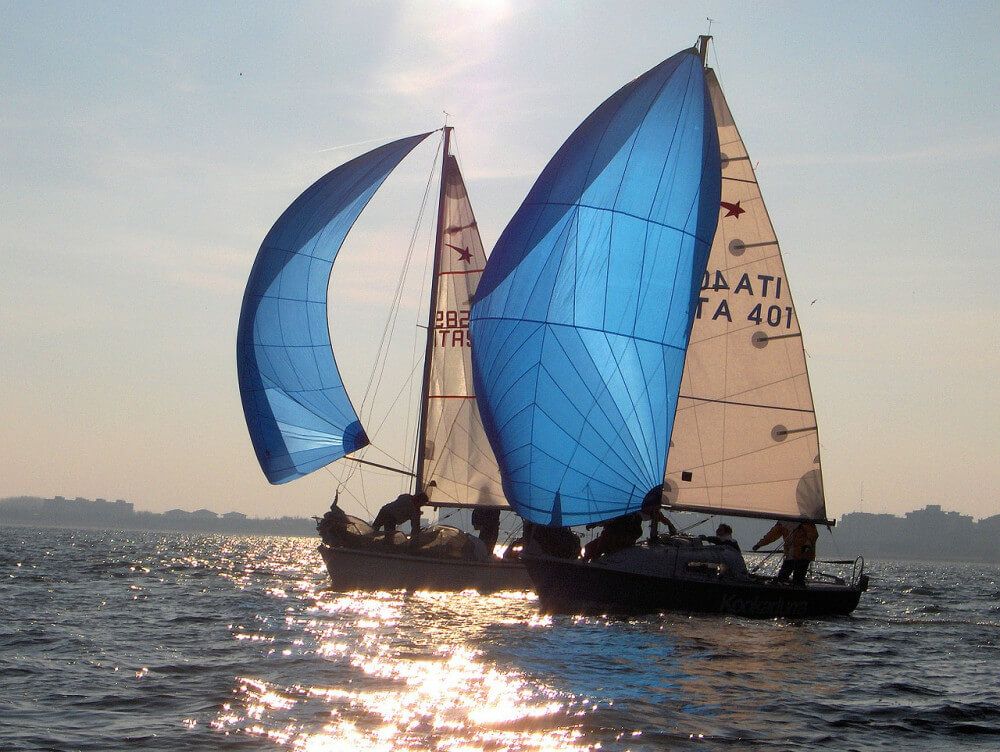

On this page:
Who issues them, do i need one, how to get yours, some tips on applying your numbers, 5 cool ideas for sail numbers, related questions.
There are four types of sail numbers, and they all get issued by different parties:
- Factory numbers - issued by the builder
- Class numbers - issued by the class association
- International numbers - issued by the national authority
- Creative numbers - issued by you
But before you start peeling off those numbers and apply some obscure mathematical theoru, lets make sure you get it right.
Factory numbers
The boat builder can put whatever number they like best on the sails. They use there own numbering systems, which are generally related to the build or hull number. They can reserve code blocks with the national authorities for larger offshore sailing yachts that require international registration. This way they won't have to break their neat number streak.
Class numbers
Class associations can also issue sailing numbers. For example, the International Laser Class Association (ILCA) issues numbers for laser racing, the International Optimist Dinghy Association (IODA) issues them for Dinghy, Tasar for Tasar, and so on.
They issue numbers to participate in their own races and tournaments. These are not internationally recognized, and there may be duplicate numbers across classes and countries. They may look something like this:
189882 BEL or ... FJ NED 775
International sail numbers
If you participate in offshore racing, or if you own an offshore racing yacht, you require international sail numbers. These are issued by your national authority. It's the fancy number with the country code as prefix. They're generally formatted something like this:
AUS 6133 or ... GBR 4567T
Check out this great resource at Wikipedia for a complete list of country codes .
The national authorities are:
- Sailing Canada
- Australian Sailing
Creative numbers
As long as you don't sail offshore and don't happen to own a yacht that can sail in international waters, you don't actually need a sail number. Your boat probably already has a number. I bet it's a boring one. Most sailboats come with numbers applied by the builder. Good news: you may remove them. You're allowed to alter them or replace them with anything like. These tend to look as follows:
Tip: If you have a sail with a build number but are unsure if its the original one: some manufacturers scribe the build number under the drawers, seats, behind pillows and so on.
So it isn't mandatory to use sail numbers for anything on inland waters. In most countries you are required to have a hull number for identification. That's a bit like a car's registration plate. But no sail number. If you do want to have a number, it doesn't have to match your hull number.
But that changes when you enter into competition. It makes sense that the race organizers need a way to identify you. To keep it simple, let me split it up. There are only three possible scenarios:
- You don't race: you use the number issued by the builder, or make up your own
- You race on inland waters: you use the number issued by the class association
- You race offshore or own a very large yacht (good for you): you use the number issued by the national authority (RYA, USS, SC, AuS)
ISAF requires country codes for sailboats international waters. Offshore numbers are essential for all racing yachts, and also recommended by the RYA for cruisers on sea. They are very important for identifying you and help with assist an rescue situations.
The RYA actually recommends all yachts to have a unique sail number. They also issue numbers for dinghy and keelboat sail, and windsurfers as well. So if you want, you can get your official GBR code, but it will cost you, and my guess is you can come up with something way more original.
You can simply apply for a number online for a small fee - currently about 30 pounds. But this is only the registration. You have to get the actual numbers yourself from a sail-maker or chandlery (they're very cheap).
Registrating a sail number costs you anywhere between $50 - $200 . In the US, registration costs you $100 - 125. In Australia: $220 AUD. Canada charges $150 CAD. The UK is actually the least expensive, at £30.00.
Canada also offers cool premium 1-digit numbers, coming in at $5,000. Be quick, only 9 left! You can also get yourself an Out of Sequence number, which is similar to the US automotive license plates. Could be great fun.
RYA : If you're a gold member, you get your number for free. Gold membership costs ... oh wait, you can only become Gold member by being a regular member for 10 consecutive years.
RYA issued sail numbers stay with the boat, even when the owner changes
RYA uses the suffixes M for monohulls and N for single-designs boats. Other than that, it's completely random.
You can apply for your numbers here:
- US Sailing (link to application form )
- RYA - UK (link to application form )
- Sailing Canada (link to application form )
- Australian Sailing (link to application form )
If you're ready to order your numbers, here are some things to consider:
- using vinyl or a cutout by a sign maker isn't a great idea - these usually fall off within a week
- the numbers use a special adhesive which can withstand water
- they are quite inexpensive so no need to cheap out
- the best numbers are sewn on, but they are more expensive (as you'd expect)
- Dacron is also good
- if you're not sure yet what you want on your sail, just order a bunch of 8s - they're easy to cut into any letter you need
- number of boats you've owned
- the year Columbus discovered the Americas (1492)
- the golden ratio (16180)
- longitude and latitude of your favorite restaurant
- your debit card pin code (no one will ever guess the obvious)
What is the sail number font? It's generally some sort of monospace (or block font). However, each class and organization uses their own font. In the US, it's common to use multiple 8s, which are then cut to size, resulting in an extreme rectangular monospace typeface.
What material are sail numbers made of? The most used material for sail numbers and insignia is adhesive backed Dacron. Dacron is a woven polyester fabric that's incredibly strong. It's one of the favorite materials used for sails up to 40'. Thanks to the tight weave it's very durable and retains shape really well.
Karta Healy
Hello Shawn Can you please assist me where Google has failed me? I recycle sails and have come across the biggest spinnaker I have ever handled. It has these number UAE 52. How does one go about finding out what the vessel they came from? Must have been a big Dubai show boat! Thanks Karta
Leave a comment
You may also like, how much do new sails cost.
Sooner or later it needs to happen: you need to replace those precious sails. Everybody knows it's expensive, but how expensive exactly? Let's look at the data.
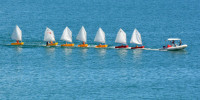
How Much Do Sailing Lessons Cost?
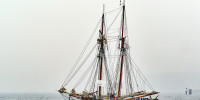
How Much Fuel Does a Sailboat Use?

How Far Can You Sail In One Day?

My Cruiser Life Magazine
What are Those Numbers on Sails? More #BoatLife Knowledge
Have you ever noticed how most sailboats have numbers on their sails? It’s one of those small details that you might not think much about.
But depending on what sort of boat you run, those numbers might carry a lot of meaning. Pretty much every boat has sail numbering, but they mean different things to different sailors.
Here’s a look at what those numbers mean and how to choose and install them if you’re ready to be noticed on the water.
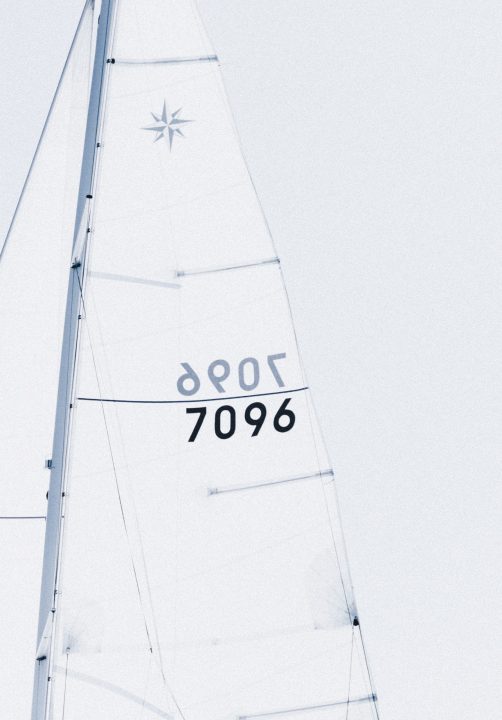
Table of Contents
What are sail numbers and what do they mean, factory numbers, one-design or class numbers (like international laser class association), racing yachts and sail number racing rules, cruising boats – owner’s choice, how to pick your numbers, how to apply sailboat numbers, sail numbers and numbers of sails, faqs – questions about sail numbering.
First off, the purpose of sailboat numbers is solely to make your boat easily identifiable from a long way away. In many instances, a group of sailboats looks indistinguishable from one another from shore. Numbers are usually shown on the mainsail, but many racing boats have them installed on every sail they have.
One thing that sail numbering is not is an official registration or documentation number. There are some cases when the number is unique and traceable, but not by any legal state authority.
In most cases, the cruising sailor will say, “so what?” But if you think about it, sail numbers can help another boat identify you and call you on the radio. For example, instead of calling the “White hulled sailboat off of Cape Henry,” a ship could call “Sailboat number 99 near Cape Henry.” That’s a lot more specific and a lot more likely to get your attention. Sail numbers are very easy to read through binoculars, after all.
In contrast, racing sailors are often identified by their numbers. In a racing class, where every boat is identical, the only distinguishing attribute on the entire boat is the number on the sails.
The same is true in the offshore racing world. Many offshore racers have unique numbers assigned by the racing governance boards in their home countries.
Four Types of Sailboat Numbers
So let’s take a closer look at the various types of numbers that might be displayed on a boat’s sails.
This one is for most cruising boats. When the boat is delivered from the factory, they install sails made by their sailmaker. These will always include the boat maker’s logo and some identifying number. Usually, this is a sequential hull number.
For example, my boat displays the distinctive CR38, indicating that it is a Cabo Rico 38. The number 99 refers to the boat’s hull number off of the factory line. Therefore, it is the 99th Cabo Rico 38 that the company made.
This system is entirely random, of course. A builder might choose a different scheme to use or put no numbers on the sails at all.
On another note, sails don’t last forever. Most sailors have to buy new sails every decade or so, and in doing so, no rule says they need to stick with the same numbering scheme the manufacturer did.
For class racing, the numbers are significant because they are often the only way to tell the boats apart while they’re on the water. The whole idea of class racing is that the boats are identical, and only the sailor’s skills win the race.
Each class association issues numbers and class rules dictate precisely how and where the number is displayed.. For example, the International Optimtimis Dinghy Association (IODA) issues numbers for several small classes.
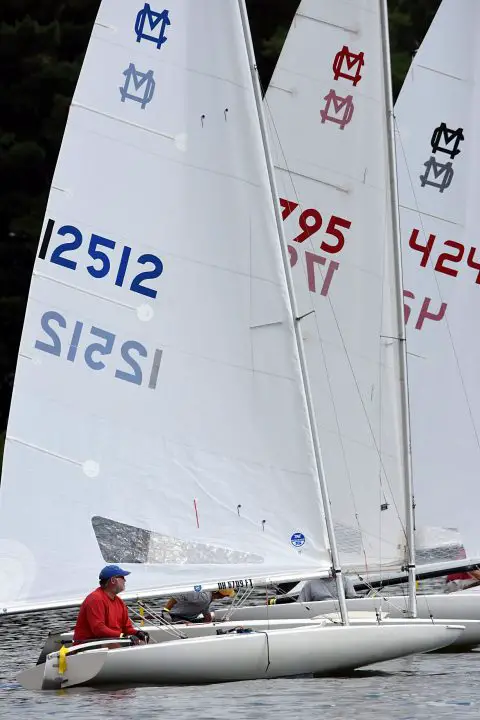
If larger boats are raced offshore in big competitions, it is usually registered with their home country’s national authority. Here in the US, that’s US Sailing. National letters or a country code will usually precede the unique sail number .
US Sailing works with regional associations around the country to ensure that sail numbers are not duplicated. But, of course, there are also large parts of the country that a regional club doesn’t cover, and in those cases, numbers are issued directly from US Sailing.
These US numbers are five digits long. The last four digits are divided up among the regional clubs. So, for example, USA 03000 would be assigned to someone from the Chesapeake Bay Yacht Racing Association .
What if the boat isn’t raced in any official events? As described above, maybe the factory installed the hull number or some other digits of significance. But if those sails are shot and it’s time for new ones, what should the skipper do?
They could choose to do nothing. If sail numbers aren’t crucial in what you do—and they aren’t for most liveaboard and traveling sailors—then you could simply not install any.
Or, you could mimic what the factory did. For example, the company insignia and number on the sail might be meaningful to you, like the maker’s badge on the hood of your car. In that case, you can have it recreated by the sail loft when they build your sails.
Or, you could do something completely original and meaningful to you and your crew. Sail lofts are using modern materials and dyes now that can make sails with printed patterns and graphics.
Many cruising sailors have designed their own logos for use on their sails. One famous example is SV Delos, whose sails feature their YouTube channel’s brand graphics and look great in their videos.
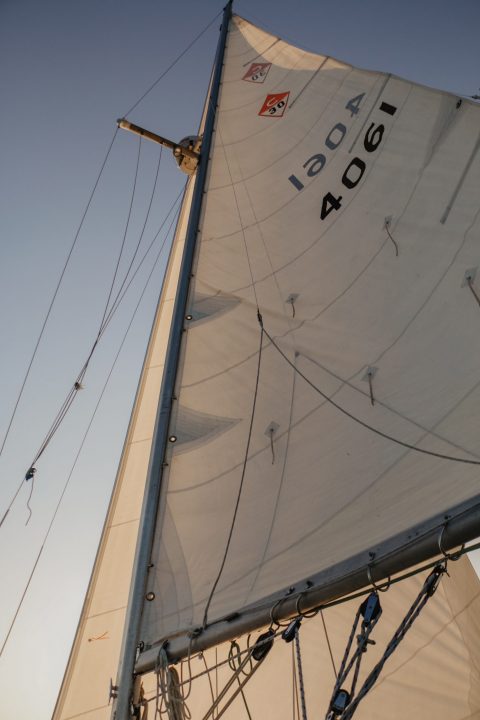
So if you have a cruising boat and need to pick some numbers, how do you figure out what to choose? If you’re buying a new sail, the sail maker can usually help you decide.
But the choice is entirely up to you. You could pick numbers of personal significance, like your birthday or anniversary. You could pick numbers about your boat, like the date you purchased her, her make and model dimensions, or the hull number.
If you don’t know your boat’s hull number, it is usually found in the middle of the HIN, which is the boat’s official hull identification number . The HIN is molded into the boat’s transom and included on all official paperwork. If your boat is registered or documented, the HIN is on the paperwork.
The first few digits of the HIN correspond to the country of origin and the manufacturer. In the middle, there should be a model code or serial number. Finally, the last four digits of the HIN are the date that the boat’s keel was laid by the factory.
If you ever want to apply your own sail numbers, it’s not hard to do. For the most part, they are made with self-adhesive lettering protected by backing paper. The biggest considerations are to ensure that the adhesive is strong enough and that material is pliable enough to be folded with the sail.
You can purchase lettering and logo material from most sail lofts or chandleries. You can also purchase pre-made block letters and numbers specifically intended for sails.
When putting the numbers on the sail, ensure that they are spaced perfectly. You’ll also want to think about how the sail will look when backlit by the sun. You can see the numbers on opposite sides, so you don’t want to let them overlap. Doing so would make both sets illegible on both the port side and starboard side.
Stingy Sailor has a great how-to on making and applying sail numbers .
Finally, we should note one final source of possible confusion. On racing sailboats, different sails are often referred to by different numbers! This isn’t an identification number specific to the boat, like the numbers discussed above.
Instead, this is a style of sail. Sails are numbered based on the wind conditions that they’re best for. Quantum Sails has a good write-up about the different shapes of jib sail and the numbers that correspond to them.
Many cruising sails may be familiar with the Code 0 (zero) sail, suitable for light air. This is an example of this numbering system used on racing boats.
What does sail number mean?
Sail numbers mean different things on different boats. They are simply a way to identify a particular boat from a distance.
On racing boats, the numbers help spectators tell who’s winning—and who’s not. On cruising boats, the numbers are often random and chosen by the boat manufacturer or owner.
How do I identify my sailboat?
Boat’s are commonly identified by a HIN, or hull identification number. This number isn’t found on the sails but rather molded into the boat’s fiberglass hull. It’s usually located somewhere on the transom.
The HIN works just like the VIN (vehicle identification number) in a car. It is unique to that boat and used on all official paperwork, like the registration. You can decode the HIN to find the manufacturer, serial number, and date of manufacture.
What is a number 4 sail?
On racing boats, different-sized headsails are given different numbers. For example, a number 4 jib is a small heavy air sail used in windy conditions.
Racers are always looking for an advantage, so like a golfer might choose a different club for a long drive, a skipper might call for a different sail combination to better match the wind speed and angle.
Matt has been boating around Florida for over 25 years in everything from small powerboats to large cruising catamarans. He currently lives aboard a 38-foot Cabo Rico sailboat with his wife Lucy and adventure dog Chelsea. Together, they cruise between winters in The Bahamas and summers in the Chesapeake Bay.

Replacing Sail Numbers: Steps, FAQs, Rules
Sometimes a previously used sail comes your way and you need to replace the sail numbers. If you have replacement numbers, you can do it yourself.
Step-by-step instructions
SailZing.com guest contributor Richard Beers, an E Scow and MC Scow sailor, shows how in this pdf document . Click on the link to read his step-by-step instructions.
Can I use acetone to remove the old adhesive?
Richard recommends denatured alcohol. Either acetone or denatured alcohol will work. Neither solvent will damage the sail. Denatured alcohol is less aggressive and won’t remove your pencil lines. Keep either solvent away from colored letters.
If the adhesive is hard to remove, soak a paper towel in the solvent and lay it on the adhesive for awhile.
Where can I get numbers?
Typically, you will get new numbers from your sail maker. Another source is SailRite .
Tell me more about number size and spacing
If you’re placing numbers from scratch, use the class rules for size and spacing (see below).
If the class rules do not specify spacing, use a proportional spacing. For example, for 15″ numbers, use a spacing of about 3″ between numbers. If the numbers “nest” together – like a 7 and 4, measure the 3″ at the closest point between the nested numbers; otherwise they will look too far apart.
How do I avoid wrinkles?
As Richard points out in his article, applying the numbers without wrinkles takes care. Even if the sail is flat, it’s easy to get wrinkles.
You might consider using different techniques for different numbers. See the diagram below.
- Open figures with flat bottoms: 1, 2, 7. Just start at the bottom of the number, peeling a little backing paper off, and following the shape while peeling adhesive off.
- Get the bottom of the figure aligned first. Then start at the bottom and peel a little backing off, working your way up vertically, pulling off the backing as you go.
- 4 and 9. If you really want to be careful, you can open up these numbers by making a slit in both the number and the backing. See the diagram.

Rules regarding sail numbers
Here are excerpts from the Scow, X, and Opti class rules regarding sail numbers.
- Sail numbers of contrasting color with lake designator shall be displayed on the mainsail at all times. 20” numbers and letters are required.
- Class A insignia shall be displayed on the mainsail at all times located in the top 1/3 of the mainsail at the 50% position.
- On both sides of her mainsail. On both sides of her after-deck.
- For mainsail, 18” min., 20” max. placed in accordance with the official sail-letter placement diagram and as follows: with vertical centerline 20” of the leading edge of batten No. 2, and with vertical spacing 12” between all club designator letters and/or racing numbers.
- On the after-deck, 10” in height, place approximately parallel to her rub-rail, facing outboard and in line.
- On sails, they shall be of widely solid contrasting colors, such as dark numbers on white or light colored sails, and white or light colored on dark material.
- Deck numbers shall be of widely contrasting color to the deck color for easy legibility.
- All letters and numbers shall be of a clear cut, vertical, block type design without serif. The stroke shall be 2.5” min., 3.5” max.
- On sails, letters and numbers may be either marked directly on the sail material or may be of a separate material securely attached thereto.
- On the deck, letters may be either painted directly thereon or may be a plate or in individual letters securely affixed to the deck.
- Letters on sails, or numbers on sails, shall not be back to back nor at the same level above the boom except where letters or numbers are symmetrical and would show identically on both sides of the sail.
Class C and X
- Each yacht must carry on both sides of her mainsail a letter, representing the Member Club from which she is entered, as well as her correct assigned racing number. Any whole integer between 0-999 is allowed. The integer ‘0’ may be represented by ‘0’, ‘00’, or ‘000;’ no other integers shall include leading zeros. The letter and number shall be placed on the sails in accordance with the official sail-letters placement diagram. Sails which have more than one club designator letter shall show the designator letters closely side by side on the same plane. An emblem, letter, or number denoting the class to which the yacht belongs may be affixed, as provided in the Class Scantlings.
- Letters and numbers must be either all blue, red, green, pink, or black of a sans serif, non-italic, non-script font style attached directly to the sail by sewing and/or adhesive. All sails shall have letters and numbers of the same color with a minimum stroke width of 2.5″ and a maximum stroke width of 3.5″.
- Letters and numbers shall be on both sides of the sail and shall not be back to back except where letters and numbers show identically the same on both sides of the sail. Letters and numbers when not back to back shall be higher on the starboard side of the sail.
- Height of letters and numbers: Class C, 18-20″; Class X, 14-16″.
- Centerline of letters and numbers will be located aft the leading edge of the first lower batten as follows, plus or minus 2″: Class C, 36″; Class X, 8″.
- Vertical spacing between letters and numbers will be no less than: Class C, 10″; Class X, 8″.
- MC insignia: The official class insignia for the MC Scow shall be the letter “C” superimposed over the letter “M”. This symbol shall appear on all sails, in letters 15″ in height and of proportional width.
- Sail numbers: Each sail shall bear the number of the yacht in figures of the same proportion as the sail symbol.
- The MC insignia shall he located above the sail numbers. Both shall be located in or near the upper half of the sail.
Here’s a diagram showing the key rules for placement . The full set of rules is shown below:
- Height: 230 mm – 240 mm
- Width (except “1” or “I”): 150 mm – 160 mm
- Width for M and W: 160 mm – 170 mm
- Thickness: 30 mm – 40 mm
- Space between adjoining numbers or letters: 40 mm-50 mm
- Space between rows of numbers or letters: 40 mm – 50 mm
- Space between the national letter groups on opposite sides of the sail: 100 mm -150 mm
- Distance between the luff and the closest letter or number in each row: 150 mm
- Distance between lower edge of uppermost batten pocket and the national letter which is closest to the leech: 40 mm – 50 mm
- Distance between number closest to the leech and the leech: as per RRS Appendix G1.2(b)
Related Posts
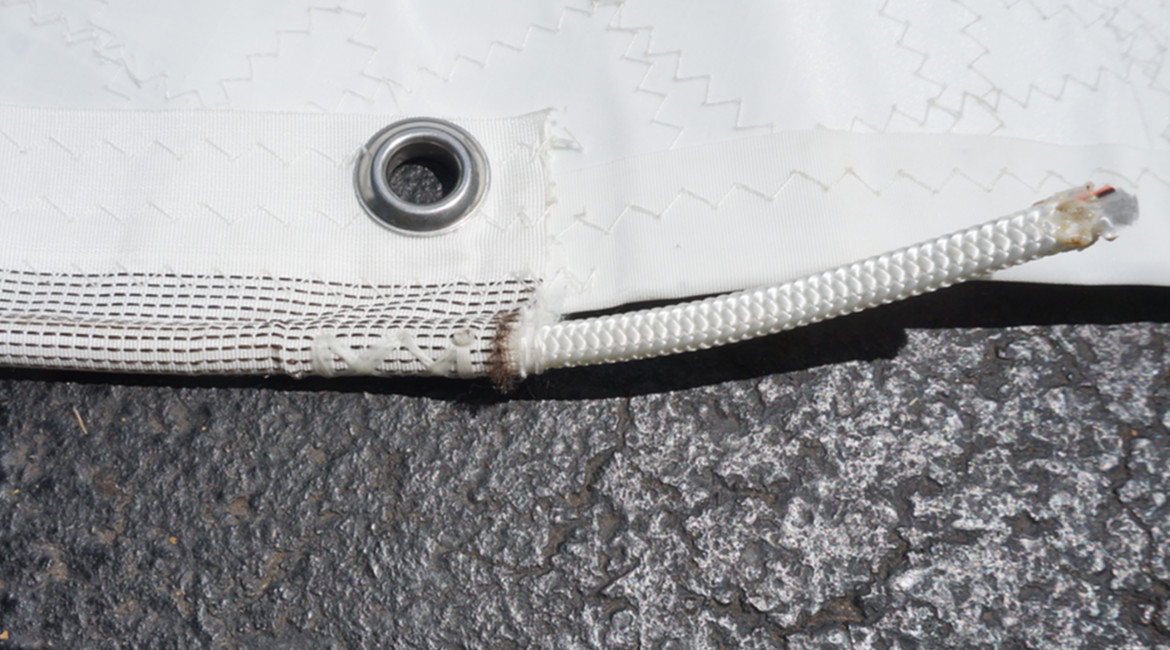
Ease the Bolt Rope to Keep Your Sail in Shape
Leave a comment cancel reply.
You must be logged in to post a comment.
This site uses Akismet to reduce spam. Learn how your comment data is processed .

The $tingy Sailor
Diy trailerable sailboat restoration and improvement without throwing your budget overboard.

How to Add Numbers to a Sail
Have a new mainsail without numbers? An old mainsail with peeling numbers? How about a used mainsail that you bought or that was given to you and has the wrong numbers on it? You can easily replace or add professional-looking numbers to your mainsail without taking it to a sailmaker and I’ll describe how.
Before I continue, a bit of legal housekeeping. This post contains affiliate links. That means I receive a small commission if you make a purchase using those links. Those commissions help to pay the costs associated with running this site so that it stays free for everyone to enjoy. For a complete explanation of why I’m telling you this and how you can support this blog without paying more, please read my full disclosure .
Our friends at Sailrite offer precision cut sail numbers in two different fonts (including a digital font for dinghies) and four sizes, enough to fit the majority of recreational sailboats. The numbers are made of high-quality, black, self-adhesive sailcloth. All you need to do is peel and stick. (In case you’re wondering, I receive no compensation from Sailrite. I just like their products and services and think you will too.)
Alternatively, you can also make your own numbers if you want to use a different font or color like I describe in How to Reproduce a Class Insignia on a Sail . If you do that project yourself, you will have plenty of extra self-adhesive sailcloth material with which to make your own sail numbers.
Off with the old, on with the new
To replace old numbers, the process is simple:
- Use a pencil to draw light guidelines right on the sail along the sides or corners of each old numeral so you know where to put the new numbers. The marks will erase easily when you’re done.
- Warm up the old numbers with a handheld hair dryer until the adhesive softens enough that you can carefully peel off the old numbers and remove all residue.
- Fold back the backing paper from one long edge of each new numeral. You want to expose just enough of the adhesive so that you can place the numeral without it sticking completely.

4. Place the exposed edge lightly in the same location as the old numeral. Be careful to not make any bubbles. If necessary, you can remove and reposition the numeral until it lays straight and flat.
5. Turn the unattached part of the numeral face down and with a piece of stiff cardboard or other material, press against the inside of the fold to unroll the backing paper from the rest of the numeral while you lightly press the newly exposed adhesive down onto the sail. You might find it easier to make the ends of curved strokes (like the 3 below) lay flat by peeling the backing paper off completely and tracing the rest of the numeral with your fingers . If you do this right, you won’t get any wrinkles, bubbles, or distortion. The numerals 4, 6, 8, 9, and 0 can be tricky to get the closed parts of the numerals to lay flat. Take your time and reposition the numeral until you get it right.

6. When you have all of the numerals where you want them, roll them firmly with a J roller if you have one. You can improvise one with a short length of dowel and use it like a rolling pin.

Numbering for the first time
To add new numbers for the first time, the process is a little more complicated because you don’t have the old numbers to work from. Instead, you will need to determine the correct size, location, spacing, and angle of the numbers yourself.
To choose the correct size numbers for your sailboat, first check what size is normally used for your class of sailboat. Ask other owners or refer to the racing rules for the class or your local race authority. A good rule of thumb is 10″ or 12″ sail numbers for boats up to 22 feet on the waterline, 15″ numbers for boats up to 32 feet, and 18″ numbers for larger boats. For Catalina 22 owners, the latest class rules (October 2014) do not require sail numbers nor specify the size of numbers. Some local clubs adopt The Racing Rules of Sailing that are updated every four years by the World Sailing organization. The rules for sail numbers and class insignia can be found in Appendix G: Identification on Sails.
Unless specified in the rules that govern the races that you participate in, you can place the numbers anywhere you like but they are typically placed in the top 60% of the sail with the class insignia above the sail numbers. This ensures that the numbers will be visible even if the sail is reefed.
A good rule of thumb for the spacing between numerals is the width of one stroke of the font in which the numerals are made. For example, if the width of the vertical stroke of the number 1 is 1-1/2″ wide, space each number 1-1/2″ apart like shown in the picture below.
The goal of all these rules is so that a sailboat can be easily identified from a distance under most conditions.

Here is how I applied numbers to a new Rolly Tasker mainsail that I purchased.
1. Determine where to place the numbers relative to the sail’s other features (seams, battens, reef points, class insignia, and draft stripe, if any). Avoid placing numbers over seams that can cause wrinkles and can cause the numbers to come loose over time. Choose a location where the numbers for each side of the sail will be vertically stacked over each other, not in the same location on each side. This makes the numbers easier to read when sunlight shines from behind the sail. A good choice is one number above a panel seam on one side of the sail and the other number below the same seam on the other side of the sail similar to the picture below. Since the seams are typically perpendicular to the leech, your numbers will automatically be at the right angle.

2. Use a pencil to draw a light guideline on the sail that will be the baseline for the sail number. Allow at least 1/2″ of space away from seams, etc. If you want the sail numbers to be horizontal relative to the boom, measure the same distance up from the foot of the sail to locate each end of the guideline. If you want the sail numbers to be angled perpendicular to the leech edge like shown above, use a panel seam as a reference or use a large framing square to draw the baseline. You can also use the old carpenter’s 3-4-5 trick to draw a perpendicular baseline. That is, a triangle with sides that are 3, 4, and 5 units long forms a 90 degree angle between the sides that are 3 and 4 units long. The units can be any measurement system: inches, feet, meters, and so on.
3. Draw a vertical guideline perpendicular to the baseline that you just drew to mark the edge of the number closest to the leech. Space the guideline one number width from the leech. For example, if the width of the number 0 is 8″, draw the guideline 8″ from the leech edge.
4. Draw additional guidelines to lay out each number one stroke width apart as shown above. On the port side of the sail, start with the numeral that is closest to the leech (the last numeral in the sail number) and work your way to the left or luff. On the starboard side of the sail, again start with the numeral that is closest to the leech (the first numeral in the sail number) and work your way to the right or luff.
The rest of the process (affixing the numbers) is the same as steps 3-6 as described above. Also refer to those pictures.
Would you like to be notified when I publish more posts like this? Enter your email address below to subscribe to this blog and receive notifications of new posts by email. You will also receive occasional newsletters with exclusive info and deals only for subscribers and the password to the Downloads page. It’s free and you can unsubscribe at any time.
Subscribe to Blog via Email
Enter your email address to subscribe to this blog and receive notifications of new posts by email.
Email Address:
Share this:
Leave a comment cancel reply.
This site uses Akismet to reduce spam. Learn how your comment data is processed .
- Already have a WordPress.com account? Log in now.
- Subscribe Subscribed
- Copy shortlink
- Report this content
- View post in Reader
- Manage subscriptions
- Collapse this bar

- [[html title]]
Sail Numbers Black
- Discontinued
- Create New Wish List
Correlated Items
Product details.
- Description
- Specifications
- Shipping Restrictions
- Questions & Answers
Sail Numbers Black are self-adhesive black Dacron ® insignia material pre-cut numbers. No sewing required. Racing rules specify at minimum 10" or 12" sail numbers for boats to 22 feet on the waterline, 15" numbers for boats to 32 feet, and 18" numbers for larger boats.
Note: #6 is the same as #9.
Numbers available in 10", 12", 15" or 18" heights.
This item is of a size or length that requires additional shipping fees.
Lithium Ion Tools can ONLY be shipped Ground to the 48 contiguous United States.
Flammable items can ONLY be shipped Ground to the 48 contiguous United States.
Lithium-Ion Batteries can ONLY be shipped Ground to the 48 contiguous United States.
Free Ground shipping is not applicable to this item.
Adding this item to your shopping cart will eliminate any air transportation shipping methods.
Adding this item to your shopping cart will eliminate the Post Office as a shipping selection.
This item cannot ship to California due to state restrictions.
Customers Also Purchased

Computer Sail Number Black 12"

How to Replace Sail Numbers & Insignia

Sail Cover Hook & Eyelet Black

Sailrite® Alphabet & Number Stamp Set 1/8" (3mm)

Sailrite® Alphabet & Number Stamp Set 1/4" (6mm)
Stay in the loop never miss sale announcements, how-to blogs, new product launches, helpful tutorials and more.
BoatNews.com
Are you participating in a regatta? All about the numbers in the sails
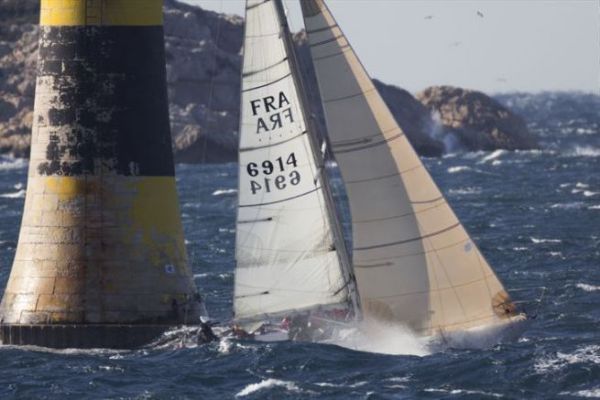
The numbers in the sails are intended for sailors, the purpose being to identify the boat during a race. Is it obligatoire?? How are the obtenir?? And how are the poser??
Are you planning to participate in a régate?? A good identification during the race is necessary for all competitors as well as for the organizers. The international sailing authorities have standardized these identifications in order to standardize them.
A number - assigned for the life of the sailboat - is therefore written in the sail . More precisely, it is the initials of your country (FRA for France) and the sequential number corresponding to the list of boats registered in the country. The identifier consists of 3 letters of nationality, then 1 to 5 digits.
Some examples of national identifiers:
- BEL Belgium
- GBR Great Britain
- GER Germany
- LUX Luxembourg
- SUI Switzerland
You don't have a numéros??
This identifier is given by the FFV Sailing to whom you must request it.
You can make this request using the form available by clicking on the link at the bottom of the article.
Your request must be accompanied by a cheque for 15.00 euros payable to the FFVoile .
If you make your first osiris gauge contract this process will be automated. If you do a iRC certificate from UNCL you will need to request a sail number separately and from the FFV Sailing.
Visibility and position
The standard for these identifiers is given in the RRS (Racing Rules of Sailing).
The vertical position is above the first third of the mainsail height. The texts tell us "the sail numbers must be, when possible, entirely above an arc whose centre is the halyard point and whose radius is 60% the length of the fall" (RRS G1.1)
The identifiers must be placed on each side of the sail , the nationality must be glued over the numbers. For good visibility, the numbers on the port and starboard sides should be offset vertically. The highest numbers must be on the starboard side.
It is necessary to use capital letters and Arabic numerals, clearly legible and of the same colour. Commercially available typographies that provide equivalent or better readability than "?Helvétique?" are acceptable.
The size of the letters and numbers depends on the length of the boat:
- - 3.50 m (dinghies): 230 mm
- from 3.50 m to 8.50 m : 300 mm
- from 8.50 m to 11 m : 380 mm
- + more than 11 m: 450 mm
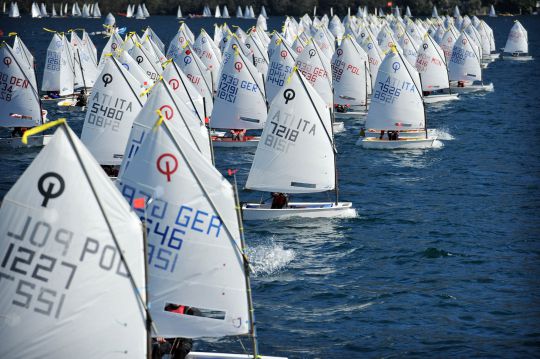
What do I need to do to put my letters and numéros? down correctly?
To get your identifiers to glue, you can get them in your sailmaker which will give you the right size. They are available in 3 colours.
To ensure that these numbers are installed yourself, here are some tips:
- Disembark your sail in a clean and dry place. With the sails in position, the result may suffer.
- Clean the area with a damp cloth and dry.
- Have a sharp pencil, a large ruler and an eraser (to erase lines after gluing).
- Identify the bonding areas for port and starboard identifiers
- Drawing horizontal lines to place the numbers will allow you to align the characters properly.
- Remove the liner (protection on the adhesive area) from a small area.
- Paste the character at the same time as you remove the liner
- After gluing, rub the numbers to raise the temperature, this will activate the glue
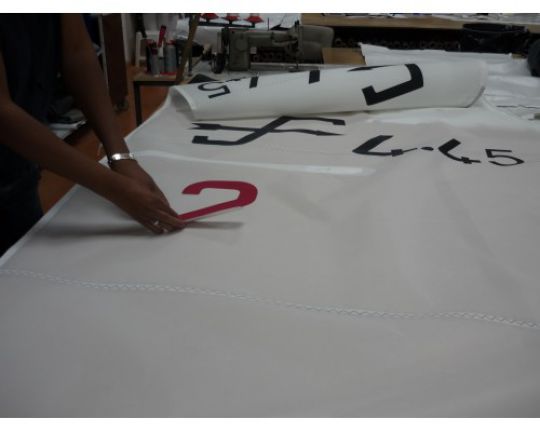

Home Competition Offshore Services
Measurement & Certification
For measurement rules managed by US Sailing, the Offshore office manages and certifies all data inputs used in the rating process through the Universal Certification System (UCS). This requires a careful attention to detail and the coordination of contributions from owners, official measurers, sailmakers, designers, boatyards, and race organizers. Data management is paramount to ensure each boat has a rating that is suitable for fair competition. For more information about measurement and rating requirements, please visit our Rating Rules and Handicapping Systems page or contact [email protected].
Beyond this, US Sailing is responsible for training official measurers for the Universal Measurement System (UMS) used by the IRC and ORC. Stationed around the country, these individuals are responsible for supplying accurate field measurements to the Offshore office.
Interested in serving the sailing community as an official yacht or sail measurer? Please contact [email protected] .
PHRF Admin Resources
The US Sailing PHRF Support Service is designed to manage sailboat data and rating information for PHRF fleets. Participating fleets have the ability to focus on defining handicaps and serving sailors, while US Sailing manages revalidations, new applications, payment, and fleet data with guaranteed security and protection. US Sailing is dedicated to providing sailing organizations with practical resources that assist in streamlining these administrative tasks.
How does the database management service work?
1. US Sailing distributes annual certificate renewal notices via email. Certificate holders can renew, modify, or enter a new boat online by logging into their “My US Sailing” page. 2. New applications and non-standardized changes received by US Sailing will be forwarded to the fleet handicapping committee for rating assessment. 3. PHRF Fleet Membership is required to participate and boat owners must be US Sailing Members. US Sailing retains a processing fee of $10 per certificate, while the remainder of the collected fees is forwarded to the fleet.
How does my fleet get started?
All US Sailing PHRF Fleet Members are eligible to use this service. Contact your fleet committee to have them join today!
To access the My US Sailing page, individual sailors must become members of US Sailing. Access to the complete PHRF Fleet Handicap Book is included with membership, join today!
For more information and answers to your questions regarding this service, please contact US Sailing at [email protected].
Stan Honey, 2010 Rolex Yachtsman of the Year
“This project is a terrific example of US Sailing’s efforts to support the large community of handicap racers around the country. It’s a great opportunity for local fleets to take advantage of US Sailing’s investment into database tools. As a long time PHRF handicap committee member, I appreciate how much effort it requires for each PHRF fleet to maintain their own database.”
Jim Walsh, Treasurer of PHRF-MA
“PHRF-MA has been using the US Sailing’s PHRF Support Service for the last two years. This service has taken away the time consuming job of tracking, printing and emailing members’ certificates from our volunteers. The response time from US Sailing to our members has been well above our expectations. Once we uploaded our database with base ratings and adjustments things have run very smooth and now our certificates go out much faster than when we did all the work. I would recommend this service to any PHRF fleet.”
Portsmouth Yardstick Admin
Clubs are invited to report their race results annually via e-mail to [email protected]. Some sample reporting sheets may be found at the bottom of this page.
Please include the following race information:
- Average Wind Speed
- Elapsed times
- Corrected Times
Various reporting formats are acceptable including Excel, Word, HTML, TXT, Sailwave, and other popular scoring programs. Please share your club or fleet’s race results to improve the validity of the Yardstick. Thank you for your interest in and use of the North American Portsmouth Yardstick. © 2011
Data Submittal Handicapping Sheet Race Committee Sheet

Safety at Sea
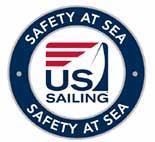
The US Sailing Safety at Sea Committee manages US prescriptions to World Sailing’s Offshore Special Regulations (OSRs), craft and maintain Special Equipment Regulations (SERs), and develops the various SaS curricula in conjunction with World Sailing and subject matter experts. These documents often serve cited under the Notice of Race (NOR) for various offshore races as points of compliance. Additionally, the Committee is responsible for considering applications for the Hanson Rescue Awards.
The Offshore office coordinates with seminar organizers to ensure appropriate measures are taken in accord with the Sanctioning Agreement and Seminar Planning Guide . This oversight ensures moderator training, guest speaker credentials, branding, scheduling, advertisement, and costing are standardized nationwide. Additionally, the office issues finalized certificates upon recommendation from event organizers.
Learn more about our safety courses
Learn more about Safety updates and improvements
Sail Numbers
US Sailing’s Offshore office is responsible for overseeing the assignment of national sail numbers in accordance with World Sailing regulations. Nationally assigned sail numbers are required for boats subject to Appendix G of the Racing Rules of Sailing and are a valuable identifying feature for any yacht.
US Sailing coordinates with several regional racing authorities to ensure sail numbers are appropriately allocated without duplication across the country.
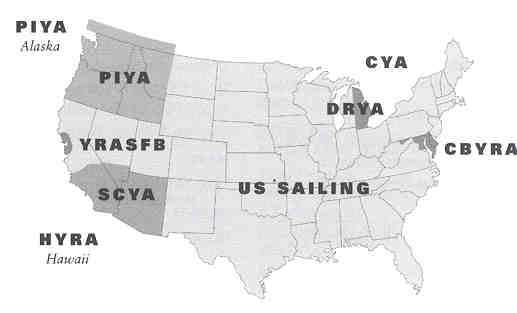
To obtain a sail number, please contact your local authority (see below). In regions administered by US Sailing, please submit your Sail Number Order and Application. Available sail numbers are allocated to these authorities as blocks as outlined in the table below. For more information, please reference the Sail Number Policy and Fee Guidelines . General inquiries may be directed to the [email protected].
For One-Design/Class sail numbers, please contact the appropriate class association.
Apply for the next available sail number
Regional Authorities
- Yacht Racing Association of San Francisco
- Detroit Regional Yachting Association
- Hawaii Yacht Racing Association
- Chesapeake Bay Yacht Racing Association
- Southern California Yachting Association
Last Four Digits – By Range of Block
| 0000- 1229 | 1300- 1399 | 1400- 2999 | 3000- 3499 | 3500- 3999 | 4000- 4250 | 4251- 4899 | 4900- 4999 | 5000- 5999 | 6000- 6999 | 7000- 7999 | 8000- 8999 | 9000- 9999 | |
| 0 | USSAIL | USSAIL | USSAIL | CBYRA | USSAIL | CYA | USSAIL | CYA | DRYA | LMYA | SCYA | YRASFB | PIYA |
| 1 | USSAIL | CYA | USSAIL | CBYRA | USSAIL | CYA | USSAIL | CYA | DRYA | LMYA | SCYA | YRASFB | PIYA |
| 2 | USSAIL | USSAIL | USSAIL | CBYRA | USSAIL | CYA | CYA | CYA | DRYA | LMYA | SCYA | YRASFB | PIYA |
| 3 | USSAIL | USSAIL | USSAIL | CBYRA | USSAIL | CYA | CYA | CYA | X | X | SCYA | YRASFB | PIYA |
| 4 | USSAIL | USSAIL | USSAIL | CBYRA | USSAIL | CYA | X | CYA | USSAIL | SCYA | SCYA | X | PIYA |
| 5 | USSAIL | USSAIL | USSAIL | CBYRA | CBYRA | CYA | X | CYA | X | SCYA | SCYA | X | PIYA |
| 6 | USSAIL | X | X | CBYRA | CBYRA | CYA | X | CYA | X | X | SCYA | X | PIYA |
| 7 | USSAIL | X | X | CBYRA | CBYRA | CYA | X | CYA | X | X | SCYA | X | PIYA |
| 8 | X | X | USSAIL | CBYRA | CBYRA | CYA | X | X | X | X | SCYA | X | X |
| 9 | X | X | X | CBYRA | CBYRA | X | X | X | X | X | SCYA | X | X |
|
| |||||||||||||
Transfer of Boat Ownership
If you are a new owner of a new sail boat or previously owned boat and plan to race the boat under one of the rating rules US Sailing issues, please use the form below to record these changes with US Sailing's Offshore Office. If you have any questions contact our office at [email protected] or 401-342-7953.
Submit Transfer Of Ownership
Sail Measurement and Certificates
US Sailing has approved measurers that are able to measure sails. If you are a US Sailing recognized sail measurer please contact [email protected] or call 401-342-7952 for the sail measurement form link.
- General Sail Measurement Guide
Other Resources:
- Cutter Rig Measurement Guide
- Gaff Rig Measurement Guide
- Sail Drive Propeller Measurement Guide
- Shaft Exposed/Out of Aperture propeller Measurement Guide
- Shaft Not Exposed ORC Propeller Measurement Guide
- Shaft Not Exposed ORR Propeller Measurement Guide
- In Aperture Propeller Measurement Guide

Copyright ©2018-2024 United States Sailing Association. All rights reserved. US Sailing is a 501(c)3 organization. Website designed & developed by Design Principles, Inc. -->

- Get Sailing
- Pleasure craft operator card
- Sustainability
- Sail numbers
- Sailing 101
- Sailing for kids
Find a Club or School
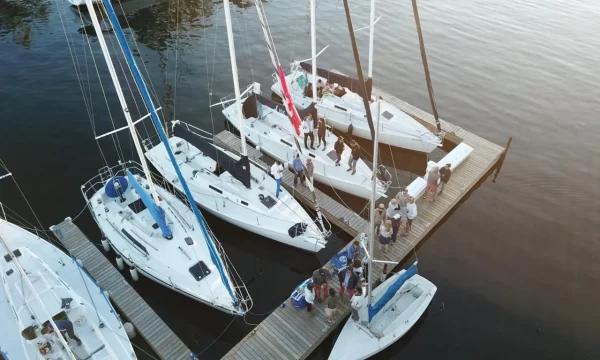
- Sailor programs
- Long Term Development
- Instructors & Coaches
- Personal Survival Training
- Courses And Seminars Calendar
- Inclusion, Diversity and Equity
Get on the water today
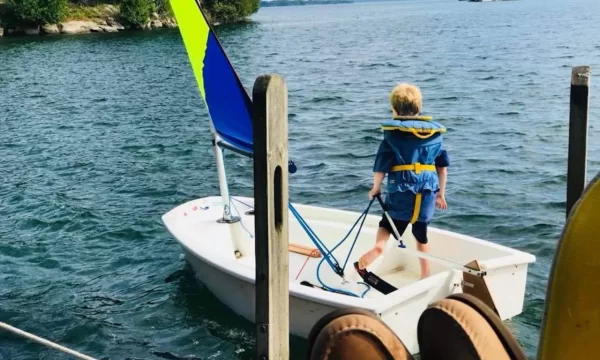
- 2024 Canadian Sailing Team
- 2024 Canadian sailing Development squad
- Teams Qualification
- National sail training centres
- International results
VIEW THE TEAMS
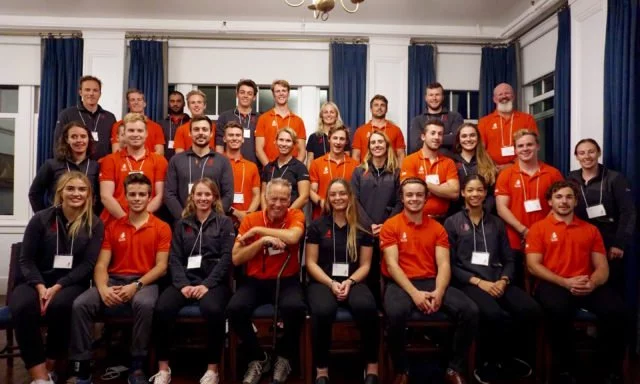
- Competition
- Sail canada championships
- Rules & regulations
- Offshore racing
- Canadian ESailing Championships
SAIL CANADA CHAMPIONSHIP
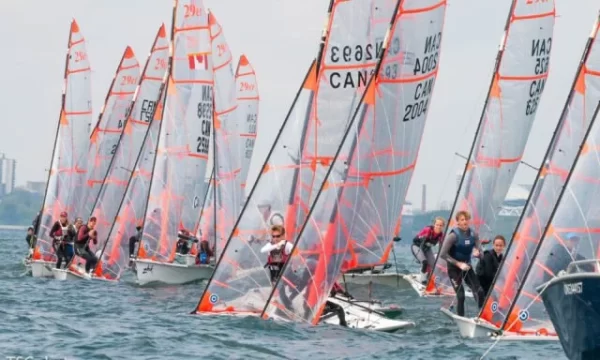
SAIL NUMBERS
Sail numbers are issued either by the Builder, Class Association or National Authority (MNA). In the case of most dinghies, smaller keelboats and one-design vessels it is the Builder or Class Association that is the number issuing authority. In the case of one-off boats, small production run, or non–one design vessels it is the National Authority that allocates Sail Numbers. Sometimes, where requested to by a class association, the MNA can take on that role.
Where there are one or more issuing authorities, two boats can have the same sail number. For example, there is a J22 numbered CAN 815 and a Shark with the same number. In this case, any distinction required is made through the class symbol on the sail.
Sail Canada allocates sail numbers to boats that don’t fall into any of the above categories. These are generally larger boats capable of offshore racing and currently, there are about 500 of these sail numbers recorded on Sail Canada’s database.
In an agreement made many years ago with US Sailing, then the USYRU, blocks of numbers were allocated to US districts and to Sail Canada, then CYA. IN 2014 US Sailing and Sail Canada agreed to set aside this agreement. This means that Sail Canada, in accordance with RRS 77 and Appendix G, is no longer restricted to the block of numbers assigned by this agreement.
With immediate effect, Sail Canada will allocate four-digit sail numbers on a consecutive basis. New five-digit sail numbers will no longer be issued. Owners will be able to request premium numbers for an additional fee. This additional fee will be treated as a donation to assist Sail Canada programs and a tax receipt will be issued.
Owners wishing to purchase premium sail numbers should call Sail Canada before completing the form to check availability.
- Sail Numbers will be issued on the next available basis unless a premium number is requested.
- The Sail Number remains with the boat unless the seller specifically requests otherwise.
- Sellers/purchasers must advise Sail Canada of the purchaser and provide contact details.
- Owners may request the retention of the numbers, if available when a boat has been imported from another MNA’s jurisdiction.
- Every Sail number issued by Sail Canada bears the country prefix CAN and this must be incorporated in the number affixed to the sail.
- The standard fees will be in accordance with the following table:
| Next available non-premium number (four digits starting at 1002) | $150 |
| Fee for retention of sail number on the imported boat (non-premium number) | $150 |
| Change of ownership (Already registered CAN numbers) | $50 |
PREMIUM SAIL NUMBERS
| $5,000 | Single Digit | 1-9 |
| $2,000 | 2 Digit ending in 0 | 10, 20, 30, 40, 50, 60, 70, 80, 90 |
| $2,500 | 2 Digit identical | 11, 22, 33, 44, 55, 66, 77, 88, 99 |
| $1,750 | All other 2 digit numbers | 12-98 excluding those above |
| $2,500 | 3 digit identical | 111, 222, 333, 444, 555, 666, 777, 888, 999 |
| $1,750 | 3 digit with 2 zeroes | 100, 200, 300, 400, 500, 600, 700, 800, 900 |
| $1,000 | 3 digit palindromic | 101, 121, 131, …..989 |
| $1,750 | 3 digit consecutive | 123, 234, 456, 567, 678, 789 |
| $750 | All other 3 digit numbers | 102 – 998 excluding those above |
| $2,500 | 4 digit identical | 1111, 2222, 3333, 4444, 5555, 6666, 7777, 8888, 9999 |
| $2,000 | 4 digit with 3 zeros | 1000, 2000, 3000, 4000, 5000, 6000, 7000, 8000, 9000 |
| $750 | 4 digit palindromic | 1001, 1010, 1212,1221,………….9898 |
| $1,250 | 4 digit consecutive | 1234, 2345, 3456, 4567, 5678,6789 |
| $150 | All other 4 digit numbers | 1002 – 9998 excluding those above |
| $200 | Out of sequence number | Excluding those above |
HST will be applied only to the non-donation portion of the fee(either $200, $150, or $50)

- Instructors & Coaches
- Rules & regulations
- Find a club/School
- job postings
- Provincial sailing associations
- Return Policy

- ISCA World Council
- ISCA Technical Committee
- USSCA Class Leadership
- ISCA Leadership
- ISCA President Letter
- ISCA Governance Documents
- ISCA Worlds Class Notice (adopted March 2024)
- ISCA Lifetime Members
- ISCA Presidents
- ISCA Exec Com Meetings
- Aruba Region
- Bahamas Regions
- Bermuda Region
- Bonaire Region
- Canada Region
- Chile Region
- Colombia Region
- Curaco Region
- Dominican Republic Region
- Ecuador Region
- Guatemala Region
- Italy Region
- Peru Region
- Puerto Rico Region
- USVI Region
- Venezuela Region
- USSCA Leadership
- USSCA President Letter
- USSCA President's Award
- USSCA Governance Documents
- USSCA Fleet Infromation
- USSCA Class Notice 2021-2024
- USSCA World Qualifier Class Notice 2025-2028
- USSCA Board Meeting Calendar
- Florida Regional Information
- Gulf Coast Regional Information
- Mid-Atlantic Regional Information
- Midwest Regional Information
- New England Regional Information
- New York Regional Information
- Southeast Regional Information
- Southwest Regional Information
- West Regional Information
- Join the Class
- 2024 Championships
- 2024 Regatta Calendar by Month
- 2024 Regional Series Calendar
- 2024 ISCA World Championship
- 2025+ Championships
- 2023 Major Championships
- 2023 Regional Series Calendar
- 2023 Regatta Calendar by Month
- 2024 Results Summary
- Past Winners
- Archived Results
- Rules & Measurement
- Sail Number Information
- World Sailing Plaques
- Does Your Boat Measure Up?
- SUNFISH Sailing Programs
- Sunfish For Sale & Repair
- Sunfish Social Media
- Windward Leg Newsletter
- The Sunfish Bible
- Event Host Resources
- ISCA Class Flag Source
- Youth Scholarship Donation
- Youth Scholarship Application
SAIL NUMBERS
A sailor who buys a new boat may retain their original sail number if the old sail is not sold with the number on it. Replacement or newly assigned numbers are to be in accordance with ISCA Class Rules . When you join USSCA you will be assigned a sail number. Sail numbers in countries other than the US are assigned by that Country's NICA (National ISCA Class Association). Further information is below.
If you are new to the class and need a number or forgot your number, please contact the Class Administrator directly - [email protected]
Sail Number Requirements
If you will be competing in any World Championship qualifying event, please be sure your sail numbers are compliant with our current class rule 3.6.5. To be fair for all competitors, provisions in the rule pertaining to size, shape, color and placement will be enforced.
SAIL NUMBER DIAGRAM 2024
Here are the highlights for compliance:
- For sails purchased after January 1, 2015: sail numbers must comply with RRS Appendix G.1 as modified by our class rules. This means that minimum height of numbers is 300mm (11-13/16”), minimum space between numbers is 50mm and numbers must still be positioned as indicated in the class diagram centered beneath the Sunfish emblem.
- For “older” sails purchased prior to January 1, 2015: numbers may comply with RRS G.1 as described above or as previously allowed in our rules prior to the latest change in January 1, 2015. This allows for “older” sails to use 10-inch numbers. Details are in our class rule 3.6.5 which should be referred to for placement, spacing and other details.
- Numbers must be of the same color.
- On white colored sails, numbers must be dark and dense, preferably black. Dark blue is acceptable.
- On dark colored sails, numbers must be white.
- Numbers must be of uniform size and shape.
- Numbers must be placed as shown on the measurement diagram, centered beneath the Sunfish emblem (not biased out toward the leech), with numbers on the starboard side placed above the seam, numbers on the port side below the seam and numbers parallel to the seam.
- Numbers provided on World Championship sails are considered compliant.
- Digital numbers: as per a World Council vote in October, 2015, digital cut numbers are currently permitted .

If further information is needed, contact the class office for assistance.
International Sunfish Class Association
8070 Willow Tree Way, Alpharetta, Georgia 30005
[email protected] +1 404-451-7743

Forgot Password?
Thumbnail Filmstrip of Sail Numbers Images
Sku: sailnumbers sail numbers.
- Description
Sail Numbers
Every racer needs sail numbers on their sail whether you sail Sunfish, Laser, Optimist, Aero, etc. These self adhesive numbers made from insignia fabric can be installed at home. Check out the boat specific sail number sizes and installation guides below.
Ordering: Make your size, color selection, and enter your needed number above but be sure to order the proper quanity of numbers in your shopping cart. Keep in mind that you need to install identical numbers on borh sides of the sail so your total quantity ordered should be double the amount of numbers in your sail number.
Number Size Guide
- Optimist Class: 230mm
- Sail Number Installation Guide
- Sunfish Class: 300mm
- Sail Number Installation Guide
- Need a Sunfish Sail Number? Join the class here to get your number.
- Laser / ILCA Class:
- First 2 numbers must be red
- 4.7 / ILCA 4: 230mm Numbers
- Radial / ILCA 6: 300mm Numbers
- Standard / ILCA 7: 300mm Numbers
- C420 Class: 300mm

- Forums New posts Unanswered threads Register Top Posts Email
- What's new New posts New Posts (legacy) Latest activity New media
- Media New media New comments
- Boat Info Downloads Weekly Quiz Topic FAQ 10000boatnames.com
- Classifieds Sell Your Boat Used Gear for Sale
- Parts General Marine Parts Hunter Beneteau Catalina MacGregor Oday
- Help Terms of Use Monday Mail Subscribe Monday Mail Unsubscribe
Whats in a sail number?
- Thread starter Dale I
- Start date Jan 30, 2003
- Forums for All Owners
- Ask All Sailors
How do you determine what the number is going to be on your new sails? Or if you buy a new boat can you take your old ones with you? Is it related to the PHRF rating, length of boat or what? ...Maybe its like the NFL where the kickers have single digits? I would assume that the letters included represent the boat Mfgr. (h = hunter, c = Catalina), but some sails have a couple and some I've seen have 4 & 5 numbers.
Sail Number The sail number is part of the Hull Identification Number (HIN) and signifies the number of that particular model made by that manufacturer. For example, my Catalina 30 built in 1990 has the HIN CTYN5900D090. CTYN is Catalina, 5900 means it is the 5900th Catalina 30 manufactured(this is also the sail number you see on the mainsail), 090 is for 1990. These numbers are an industry standard so all boats use the same system. You can find your "sail number" on the HIN inscribed on your hull.
newly anonymous
it's your call Many one-off boats have five digit numbers, even though they're hull #1, because too many low numbers in a handicap fleet leads to confusion. Since my h410 was the 47th one built, I chose the number 41047. Had I used my hull ID number as David suggested, I would have been 41147, because Hunter starts numbering its hulls at #101 to get around the fears of those who don't want to buy early into a production run.
LaDonna Bubak - CatalinaOwners.com
Sail numbers I read a very sweet story recently about a gentleman who, when he had new sails made, had the the date he & his wife met be his sail number. Can I hear a collective "AWWWWWWW....." LaDonna
CCA racing sail numbers were issued to the boat. 1578 was issued to my 1966 Lecomte and stay with the boat. Many new boats boats use their length or hull ID but these are not "official" numbers
US Sailing Assignment... US Sailing doles out sail numbers for those that want to be "official". They will also recognize a 'state agency' for sail numbers. If you plan on doing a lot of racing in nationally recognized events, then it might be a good idea to get a US Sailing assigned number (for which you pay). If you are just doing local and club racing, pick a number that no one else is using and it becomes yours by first dibs. Most will choose their hull number as part of it. The link gives US Sailing take on this...
Chuck Wayne
- This site uses cookies to help personalise content, tailor your experience and to keep you logged in if you register. By continuing to use this site, you are consenting to our use of cookies. Accept Learn more…
Table of Contents
- the insignia denoting her class;
- at all international events, except when the boats are provided to all competitors, national letters denoting her national authority from the table below. For the purposes of this rule, international events are World Sailing events, world and continental championships, and events described as international events in their notices of race and sailing instructions; and
- a sail number of no more than four digits allotted by her national authority or, when so required by the class rules, by the class association. The four-digit limitation does not apply to classes whose World Sailing membership or recognition took effect before 1 April 1997. Alternatively, if permitted in the class rules, an owner may be allotted a personal sail number by the relevant issuing authority, which may be used on all his boats in that class.
- National letters and sail numbers shall be in capital letters and Arabic numerals, clearly legible and of the same colour. Commercially available typefaces giving the same or better legibility than Helvetica are acceptable.
- The height of characters and space between adjoining characters on the same and opposite sides of the sail shall be related to the boat’s overall length as follows:
- Except as provided in rules G1.3(d) and G1.3(e), class insignia, national letters and sail numbers shall, if possible, be wholly above an arc whose centre is the head point and whose radius is 60% of the leech length. They shall be placed at different heights on the two sides of the sail, those on the starboard side being uppermost.
- The class insignia shall be placed above the national letters. If the class insignia is of such a design that two of them coincide when placed back to back on both sides of the sail, they may be so placed.
- National letters shall be placed above the sail number.
- The national letters and sail number shall be displayed on the front side of a spinnaker but may be placed on both sides. They shall be displayed wholly below an arc whose centre is the head point and whose radius is 40% of the foot median and, if possible, wholly above an arc whose radius is 60% of the foot median.
- The national letters and sail number shall be displayed on both sides of a headsail whose clew can extend behind the mast 30% or more of the mainsail foot length. They shall be displayed wholly below an arc whose centre is the head point and whose radius is half the luff length and, if possible, wholly above an arc whose radius is 75% of the luff length.
Previous Versions
Last updated.
| Rules | ||
|---|---|---|
| Racing Rules of Sailing for 2013-2016; Version 6 | December 2015 | |
| Racing Rules of Sailing for 2017-2020 | August 2017 | |
| Racing Rules of Sailing for 2021-2024 | December 2020 | |
| Prescriptions | ||
| Australia | July 2017 | |
| Canada | November 2019 | |
| Great Britain - RYA has declined to grant a license for prescriptions and cases. | November 2019 | |
| New Zealand | July 2017 | |
| United States | February 2017 | |
| Cases | ||
| World Sailing Cases | February 2022 | |
| World Sailing Q&As | March 2022 | |
| Match Race Calls | January 2020 | |
| Match Race Rapid Response Calls | October 2018 | |
| Team Race Calls | December 2018 | |
| Team Race Rapid Response Calls | February 2016 | |
| CAN Cases | October 2017 | |
| RYA Cases | November 2019 | |
| US Appeals | November 2019 | |
| Manuals | ||
| World Sailing Judges Manual | December 2019 | |

- No menu assigned!
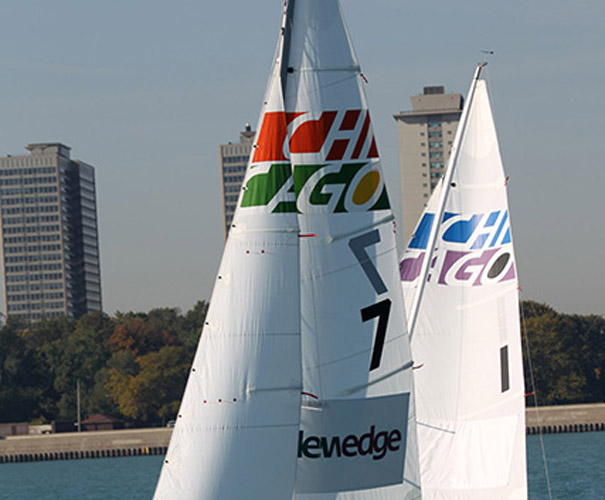
- Sail Numbers
$ 5.00 – $ 400.00
We can print your sail numbers on a variety of resilient materials. Let us know your requirements and we can help you chose an option that’s best for you.
Please note, production time is 3-5 business days.
Deleting file, please wait...
Sail Number
Additional information.
| Weight | 1 lbs |
|---|---|
| Dimensions | 36 × 1 × 1 in |
| Size | 6", 10", 12", 15", 18", 21", 24", 30" |
| Color | Blue, Black, Green, Red, White |
| Single / Pair | Single, Pair |
Related products

- Class Insignias
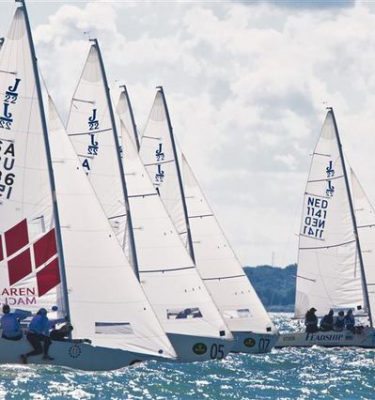
- Country Codes
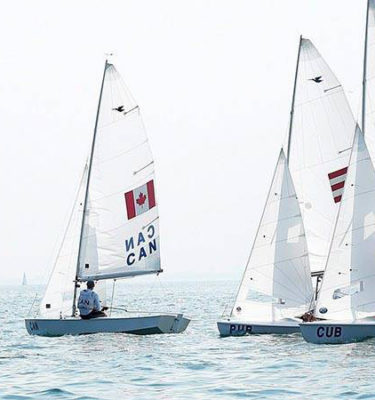
Country Flags (World Sailing Approved)
CUSTOM GRAPHICS
- Hull Graphics
- Flags & Banners
- Regattas & Events
STANDARD GRAPHICS
- Class Logos
- Country Flags
© 2024 North Sails Graphics. Terms & Conditions | Privacy Policy | Cookies | Cancellation/Refund Policy & Shipping Information
- Request a Quote
- Social Distance Decals
- Order Online
High School and College Sailors - 15% Off Apparel & Accessories - LEARN MORE

- Call Us +1-503-285-5536
- Sign in & Register
- Recently Viewed
- One Design Parts
Sail Number 12" Pre-Cut Euro
West coast sailing.
- Create New Wish List
Write a Review

Frequently Bought Together:

Description
These 12 inch die-cut sail numbers have a sticky adhesive on one side that will bind them to the sail. Once applied and set, the numbers will be able to withstand the elements of sailing without falling off. If you need to change your numbers for any reason or add new ones, they can be peeled off by hand.
- Available in Blue, Red, and Black
- 'European' style - smooth with round corners
- Die cut for clean finish
- Used on a variety of one design sailboat sails
- Approved Classes: Laser, Laser Radial, 420, FJ, V-15, RS Aero
- 12" Country Code Letters approved for 2022 RS Aero Worlds (7 Rig & 9 Rig)
- Sticky Adhesive Binds to Sail
Need to purchase 100+ numbers? Contact our team about wholesale pricing for large volume sail number orders by calling/texting 1-503-285-5536 or emailing [email protected].
Product Reviews
Shipping & returns.
Delivery Info: Enjoy Free Standard Shipping on most orders* to the Continental United States over $99. Our Standard Shipping method utilizes USPS, UPS, and FedEx to send packages near and far. Oversize/Freight shipping (where applicable), Expedited Shipping (where available), and rates to other destinations will be calculated at checkout.
See our Shipping Page for more information (and exceptions).
Returns Info: Your 100% satisfaction is our goal - we want you to love your sailing gear, but if something doesn't work out, we accept returns on most new, unused items*. Returns can be made within 366 days (1 year + 1 day) of your original order date. Exceptions include (and are not limited to) cut line, Rig Shop products, special order items, numbered sailors, and items used or worn sailing.
See our Returns Page for more information.
Prop 65 Warning
Related Products

Sail Number 9" Pre-Cut Euro

Sail Number 12" Digital

Tasar Sail Numbers

Sail Number 9" Digital

RS Aero Sail Numbers
Subscribe to our newsletter.
Sign up for our newsletter to receive exclusive discounts, new product announcements, and upcoming sales.
- sail-numbers
Sail Numbers
offshore sail numbers.
The RYA Technical Department issues offshore sail numbers, essential for all racing yachts and advisory for cruising yachts venturing to sea.
These sail numbers are an important way of uniquely identifying a yacht for search and rescue purposes, and are a requirement of the Racing Rules of Sailing, Rule 77 - Identification on Sails. The RYA recommend that all yachts have a unique sail number.
If the owner sells the boat on, except in exceptional circumstances, the sail number remains with the boat and details of the new owner should be passed on to the RYA Technical Department with the appropriate registration fee. Sail Numbers will be in the form of: GBR four digit number with a suffix of L, T or N e.g. GBR 4567T. Multihulls will be given a suffix of M.
Allocation of a single number is free of charge to RYA Gold Members, £20.00 RYA Personal Members, and £40.00 to non members and companies. Click here to apply for an Offshore Sail Number .
It is also possible to obtain an Out Of Sequence sail number. These are a great way of personalising your vessel with a meaningful number. These are subject to availability, for further details and prices please contact either [email protected] or call 02380 60 4200.
Dinghy & Keelboat Sail Number Allocation/Building Fees
The RYA issue sail numbers and collect the building fees (design royalties) for all the following classes:
| Albacore | £72.00 |
| Eighteen | £20.42 |
| Firefly | £128.40 |
| Graduate | £128.40 |
| Hornet | £206.40 |
| Merlin-Rocket | £20.42 |
| Scorpion | £156.00 |
| Solo | £128.40 |
| Sonata | £324.00 |
| Squib | £246.00 |
| Swallow | £66.38 |
For all RYA administered International Classes, except the Dragon, the fee is £40.00 unless the application is accompanied with a current RYA Membership number when the fee is £20.00. The Dragon Class fee is £50. All prices are inclusive of VAT at 20%.
Windsurfing Sail Numbers
To apply for a Sail Number for your windsurfer please contact [email protected] or phone 023 8060 4200 and have your RYA membership number available.
Block of Sail Numbers
If a class or builder is interested in reserving a block of sail numbers, then please contact the RYA Technical Department. For example, the Hunter 707 Class have the GBR 7000N series, the 1720 Sportsboats have the GBR 1720L series. It is possible to reserve a batch of sail numbers and pay as and when the next boat is built. In addition special numbers either singular or in block, can be made available at special rate. Just ask. If you would like anymore information on sail numbers please contact us by email or on 023 8060 4200.
Fast Dispatch, Fast Delivery and a 5 Star Rated Service

- MENS SAILING CLOTHING
- DYNEEMA TRAPEZE LINES AND ROPES
- SINGLE SHEAVE BLOCKS
- Gelcoat Fillers
- Dry Lubricants
- Adhesive Glues
- Hooks & Clips
- Catamaran Launching Trollies
- Jockey Wheels
- Hitch Locks
- Lighting Board
- Breakaway Cables
- Clew Straps
- Upper Masts
- Lower Masts
- Rope Thimbles
- Wind Indicators & Burgees
- Parrel Beads
- Whipping Twine
- Sailmakers Palm
- Digital Compasses
- DEVOTI ILCA
- LASER SAIL BOATS & DINGHYS
- BAHIA SAIL BOATS & DINGHYS
- Numbers & Letters
- Dinghy Covers
- Under Covers
- Catamaran Covers
- Single Handed
- Double Handed
- 18 Foot Skiff
- Exocet Moth
- Musto Skiff
- Dart 15/ Sprint 15
- Hurricane 5.9
- Laser Bahia
- Laser Cascais
- Laser Funboat
- Laser Stratos
Your Cart is Empty
- £0.00 Subtotal
Tax included and shipping calculated at checkout
Order before midday Monday to Friday and we will ship your order the same day.
- 01268 222912
- Accessories
- Laser Products
- Sails & Covers
- Rope Lengths
- Parts By Boat
- Boat Care & Cleaning
- Splicing Tools
- Boat Covers
- Dinghy Rope Lengths
- Laser Rope Lengths
- RS Rope Lenghts
- Catamaran Rope Lengths
- Laser Performance
- Topper Sailboats
- Other Boats

Pay in 30 days or split over 3 months
- Mens Sailing Clothing
- Womens Sailing Clothing
- Junior Sailing Clothing
- Repair Kits
- Skiff Suits
- Life Jackets
- Trapeze Harnesses
- Buoyancy Aids
- Hiking Pads & Pants
- Hiking / Toe Straps
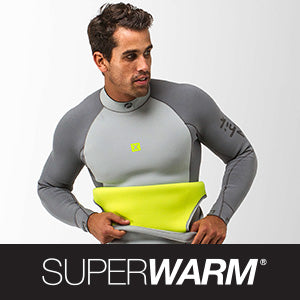
Zhik Superwarm
- 100m Rope Reel
- 50m Rope Reel
- Polyester Ropes
- Control Lines
- Double Braids
- Braid On Braid
- Anchor Lines & Ropes
- Spools & Reels
- Windsurfing
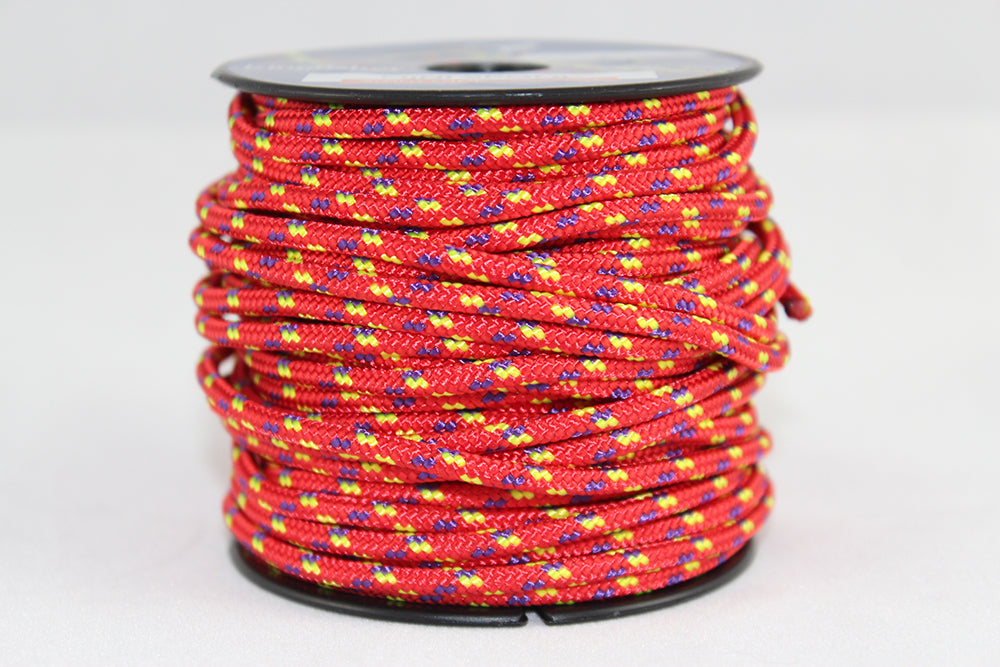
Mini Spools
- Single Block
- Double Block
- Triple Block
- Soft Attach
- Split Rings & Pins
- Inspection Hatches & Covers
- Bungs & Sockets
- Rudder & Tiller Parts
- Bushes & Fairleads
- Marine Screws
- Penny Washers
- VHF Aerials & Antennas
- Marine Tapes
- Traveller Systems And Parts
- Traveller Blocks
- Pico Hull & Deck Fittings
- Hull & Deck Fittings
- Laser Boats
- Laser Sails
- Laser Sail Packages
- Laser Spars
- Laser Rig Packages
- Laser Foils
- Laser Hull & Deck Fittings
- Laser Ropes
- Laser Dinghy Covers
- Devoti ILCA Boats
- ILCA Sail Packages
- ILCA Rig Package
- Devoti D-Zero Boats
- Devoti D-Zero Parts
- Devoti KDK Boats
- ILCA Charter Boats
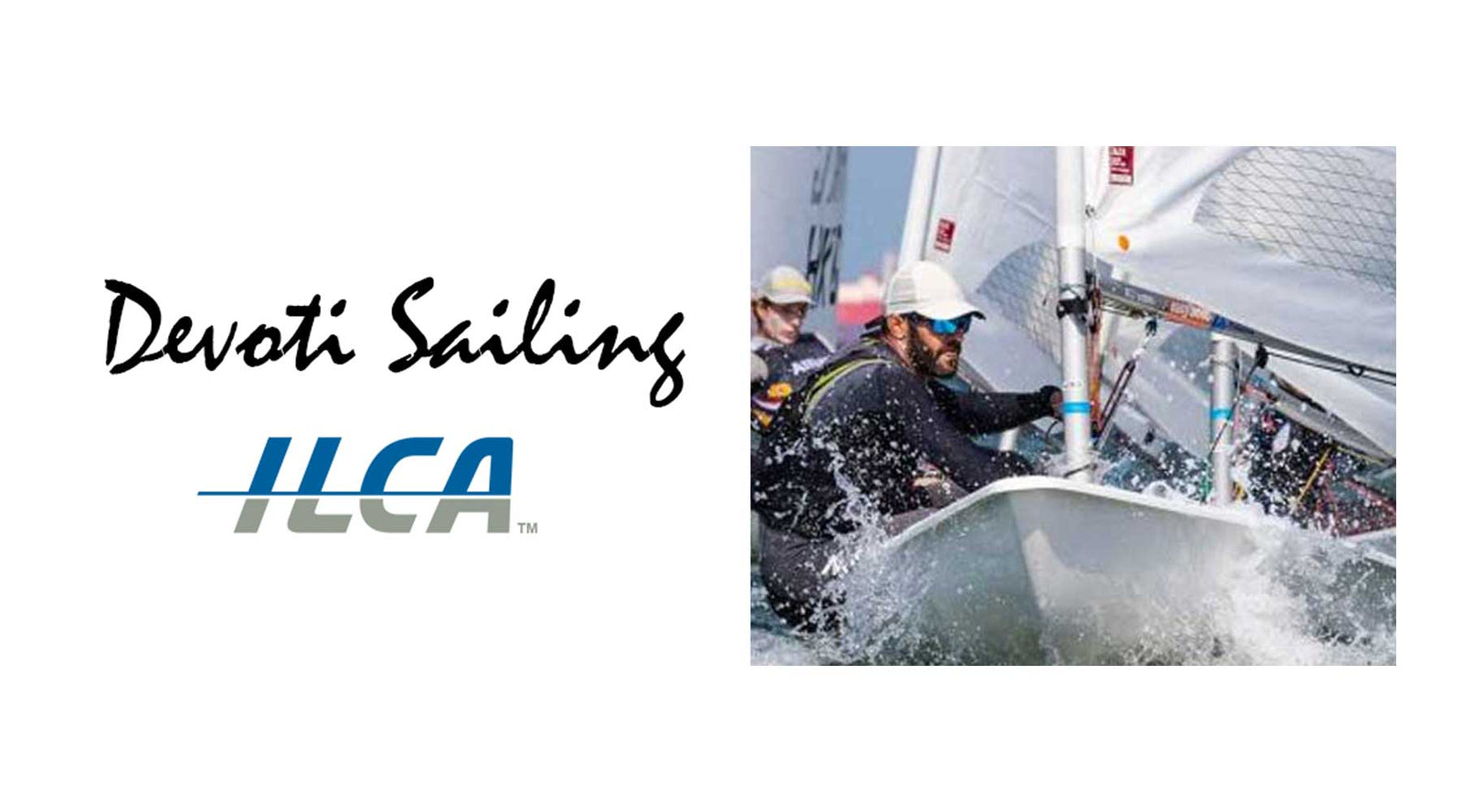
New Devoti ILCA
Search our chandlery
Sail letters & numbers, laser models, topper sailboats models, rs sailboats models, devoti models, availability.
- Out of stock
Sail numbers and letters available for your sails. Our sail numbers and sail letters are made from dacron with self adhesive backing so they are easy to stick on.

Let customers speak for us
Used 2 of these to replace the little plastic ones on a supernova tiller. Much better and now pull in the right direction
This is the perfect tool to assist in tightening my Dart Trampoline. It grips the rope far better than you can with your hands.
After having my Previous Superwarm X Suit for over 5 years whilst working as a watersports instructor this is a great improvement over the previous suit. Warmer and softer linning throughout the inside of the suit and I will continue to use the suit all year round like my old suit.
Someone at the club “borrowed “ one of my Solo’s bungs. I bought two so now I have a spare.
Great to have something that goes over everything if a quick solution is required
had ordered one on amazon before, received the wrong size received the correct size now :)
A simple moulded part of good quality, supplied quickly and well packed.
Turned out that I had ordered the wrong make, my camcleats being Allen not Harken, however by drilling the two fixings holes out by 1mm and filing two small notches they fitted perfectly.
Super helpful company. Attentive, and quick to deliver.
Second time I have use for this purpose. Really easy to attach to alloy mast and so easy and positive to operate.
We have put the boat on this trolley but not yet used it for launch and recovery. First impressions are very good, It fits together well and is super easy to assemble - it's made to put together and take apart fast if you want to put it in a vehicle etc. It is very lightweight which should be a boon launching and recovering the boat - at the same time it looks strong and well made. Being aluminium we won't have a rust problem either. I was impressed how it fits perfectly wherever it supports the boat. So assuming it performs well in use we are pleased we got this. Very helpful guy on the phone and it came quickly so all good, thanks,
Good service, and fast delivery. Very happy with my large amount of assorted short lengths of rope of many different thicknesses for practising my knots.
Good quality rope that can be spliced. Delivered promptly by the Sailing Chandlery.
Excellent sail, ideal for training and comes with a sailbag, Our only drawback was the long delivery time (2-3 weeks) and having to pay €90 in customs charges all due to Brexit! If Sailing Chandlery had a outlet here in the Republic or in Northern Ireland, business could get much better.
Worked a treat
The Puco hatches I bought hatch really well for hatchy things. Speedy service and great value. Hatch-on!
Best Sellers

Hints and Tips

Looking After You ILCA Spars
September 13, 2024 3 min read

ILCA Outhaul Calibration Markers
April 17, 2024 3 min read

ILCA Daggerboard Calibration Sticker
April 17, 2024 1 min read
SIGN UP TO OUR NEWSLETTER
Save up to 40% on your next order.

Laser Performance
- Laser Sailboat Class Legal Parts
- Laser Sails, Battens and Sail Numbers
- Laser Sail Numbers
Sunfish Sail Numbers & Letters 12 in. (price per digit)
Write a review.

- Create New Wish List
- Description
Sunfish Sail Numbers & Letters, 12 in.

IMAGES
VIDEO
COMMENTS
Free shipping on qualified orders. Free, easy returns on millions of items. Browse & discover thousands of brands. Read customer reviews & find best sellers
You have to get the actual numbers yourself from a sail-maker or chandlery (they're very cheap). Registrating a sail number costs you anywhere between $50 - $200. In the US, registration costs you $100 - 125. In Australia: $220 AUD. Canada charges $150 CAD. The UK is actually the least expensive, at £30.00.
Sail numbers are made from an adhesive backed insignia cloth and provide identification on your sail. 9, 10, and 12 inch numbers in digital and precut styles in stock. ... For Laser sails, select the 12 inch numbers in either Digital 8 or Euro style. We also stock Hobie Cat specific numbers for boats like the Hobie 16, Hobie 17, and Hobie 17 ...
So, the first boat will have sail number 1, the 1000th will have sail 1000. Not all boats will come with numbered sails. However, racing sailboats will always have them. The numbers are then used to identify boats in races. After some time, the sail number and the boat become the boat's identity, so when replacing sails the buyers usually ...
The number 99 refers to the boat's hull number off of the factory line. Therefore, it is the 99th Cabo Rico 38 that the company made. This system is entirely random, of course. A builder might choose a different scheme to use or put no numbers on the sails at all. On another note, sails don't last forever.
Sail numbers: Each sail shall bear the number of the yacht in figures of the same proportion as the sail symbol. The MC insignia shall he located above the sail numbers. Both shall be located in or near the upper half of the sail. Optimist. Here's a diagram showing the key rules for placement. The full set of rules is shown below:
Sail Numbers. When you need to identify your vessel with numbers, get the job done right with Sailrite. We offer premade sail numbers in a variety of heights, as well as a DIY version that you can make into any number you need with just a few quick cuts. Stay in the loop! Never miss sale announcements, how-to blogs, new product launches ...
A good rule of thumb is 10″ or 12″ sail numbers for boats up to 22 feet on the waterline, 15″ numbers for boats up to 32 feet, and 18″ numbers for larger boats. For Catalina 22 owners, ... Allow at least 1/2″ of space away from seams, etc. If you want the sail numbers to be horizontal relative to the boom, measure the same distance up ...
Sail Numbers Black are self-adhesive black Dacron ® insignia material pre-cut numbers. No sewing required. Racing rules specify at minimum 10" or 12" sail numbers for boats to 22 feet on the waterline, 15" numbers for boats to 32 feet, and 18" numbers for larger boats. Note: #6 is the same as #9. Numbers available in 10", 12", 15" or 18" heights.
A number - assigned for the life of the sailboat - is therefore written in the sail. More precisely, it is the initials of your country (FRA for France) and the sequential number corresponding to the list of boats registered in the country. The identifier consists of 3 letters of nationality, then 1 to 5 digits.
Here at Sailing Chandlery we sell Digital 8 sail numbers in two different sizes and colours. We stock 300mm (12 inch) high numbers and also 230mm (9 inch) high numbers. All numbers are cut from self adhesive cloth so you can peel the back off and stick the numbers directly onto your sail. To give you an idea, a standard or radial Laser sail ...
Sail Numbers. US Sailing's Offshore office is responsible for overseeing the assignment of national sail numbers in accordance with World Sailing regulations. Nationally assigned sail numbers are required for boats subject to Appendix G of the Racing Rules of Sailing and are a valuable identifying feature for any yacht.
The Sail Number remains with the boat unless the seller specifically requests otherwise. Sellers/purchasers must advise Sail Canada of the purchaser and provide contact details. Owners may request the retention of the numbers, if available when a boat has been imported from another MNA's jurisdiction.
For sails purchased after January 1, 2015: sail numbers must comply with RRS Appendix G.1 as modified by our class rules. This means that minimum height of numbers is 300mm (11-13/16"), minimum space between numbers is 50mm and numbers must still be positioned as indicated in the class diagram centered beneath the Sunfish emblem. For "older ...
Standard Sail Number. Please process payment here and complete the US Sailing Standard Sail Number Application. Per the Racing Rules of Sailing, the US Sailing issues sail numbers that meet national and international standards. Nationally assigned sail numbers are required for boats subject to Appendix G of the Racing Rules of Sailing and are a ...
First 2 numbers must be red. 4.7 / ILCA 4: 230mm Numbers. Radial / ILCA 6: 300mm Numbers. Standard / ILCA 7: 300mm Numbers. Sail Number Installation Guide. C420 Class: 300mm. Sail Number Installation Guide. Every racer needs sail numbers on their sail whether you sail Sunfish, Laser, Optimist, Aero, etc. These self adhesive numbers made from ...
Jan 31, 2003. #2. Sail Number. The sail number is part of the Hull Identification Number (HIN) and signifies the number of that particular model made by that manufacturer. For example, my Catalina 30 built in 1990 has the HIN CTYN5900D090. CTYN is Catalina, 5900 means it is the 5900th Catalina 30 manufactured (this is also the sail number you ...
G1.1. Identification. Every boat of a World Sailing Class shall carry on her mainsail and, as provided in rules G1.3 (d) and G1.3 (e) for letters and numbers only, on her spinnaker and headsail. the insignia denoting her class; at all international events, except when the boats are provided to all competitors, national letters denoting her ...
North Graphics 2549 Business Parkway Minden, NV 89423 Phone: 619-224-8667 [email protected]
Sail numbers are made from an adhesive backed insignia cloth and provide identification on your sail. 9, 10, and 12 inch numbers in digital and precut styles in stock. Free Shipping Over $99 - 366 Day Returns - Expert Advice ... select the 12 inch numbers in either Digital 8 or Euro style. We also stock Hobie Cat specific numbers for boats like ...
Available in Blue, Red, and Black. 'European' style - smooth with round corners. Die cut for clean finish. Used on a variety of one design sailboat sails. Approved Classes: Laser, Laser Radial, 420, FJ, V-15, RS Aero. 12" Country Code Letters approved for 2022 RS Aero Worlds (7 Rig & 9 Rig) Sticky Adhesive Binds to Sail.
The RYA recommend that all yachts have a unique sail number. If the owner sells the boat on, except in exceptional circumstances, the sail number remains with the boat and details of the new owner should be passed on to the RYA Technical Department with the appropriate registration fee. Sail Numbers will be in the form of: GBR four digit number ...
Our sail numbers and sail letters are made from dacron with self adhesive backing so they are easy to stick on. 300mm Sail Numbers - Black. 1 review. £2.25. 230mm Sail Numbers - Black £2.25. Sold out. Black 300mm Digital 8 Sail Number Slanted With Notch £3.06. Sold out. 300mm Sail Numbers - Red £2.25.
Color: Current Stock: Quantity: Add to Wish List. Description. Sunfish Sail Numbers & Letters, 12 in. Buy Sunfish Sail Numbers 12 in., sailboat parts, sails and running rigging at Vela Sailing Supply. Technical support, customer service and product information. Vela and sailing supplies.